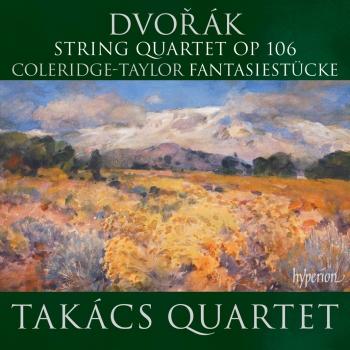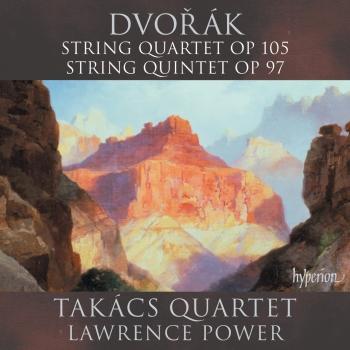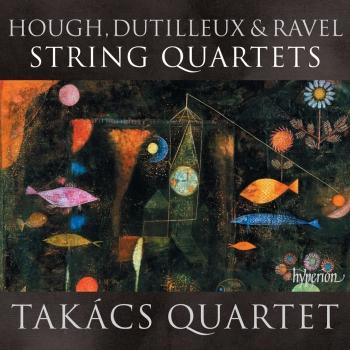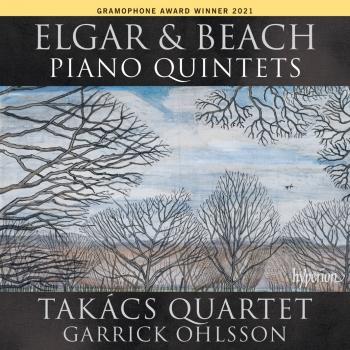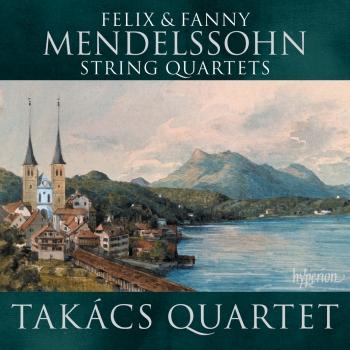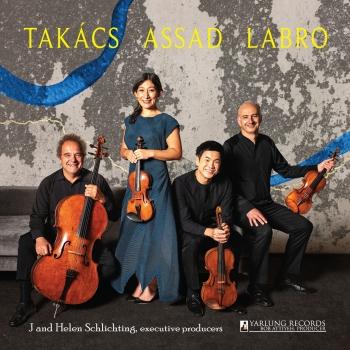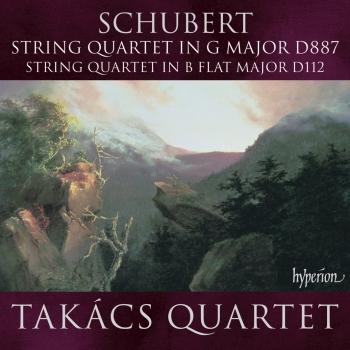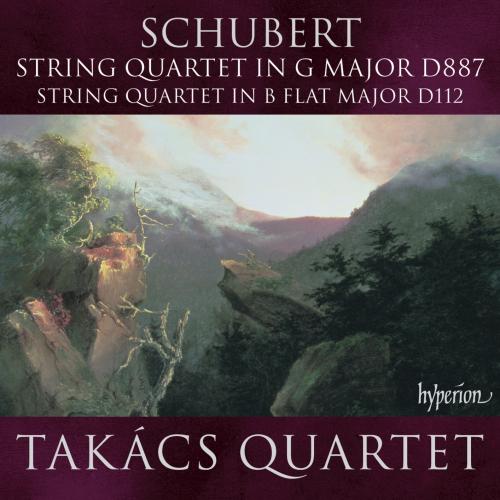
Schubert: String Quartets D. 112 & 887 Takács Quartet
Album Info
Album Veröffentlichung:
2024
HRA-Veröffentlichung:
31.05.2024
Label: Hyperion
Genre: Classical
Subgenre: Chamber Music
Interpret: Takács Quartet
Komponist: Franz Schubert (1797-1828)
Das Album enthält Albumcover Booklet (PDF)
Entschuldigen Sie bitte!
Sehr geehrter HIGHRESAUDIO Besucher,
leider kann das Album zurzeit aufgrund von Länder- und Lizenzbeschränkungen nicht gekauft werden oder uns liegt der offizielle Veröffentlichungstermin für Ihr Land noch nicht vor. Wir aktualisieren unsere Veröffentlichungstermine ein- bis zweimal die Woche. Bitte schauen Sie ab und zu mal wieder rein.
Wir empfehlen Ihnen das Album auf Ihre Merkliste zu setzen.
Wir bedanken uns für Ihr Verständnis und Ihre Geduld.
Ihr, HIGHRESAUDIO
- Franz Schubert (1797 - 1828): String Quartet No. 15 in G Major, D. 887:
- 1 Schubert: String Quartet No. 15 in G Major, D. 887: I. Allegro molto moderato 21:16
- 2 Schubert: String Quartet No. 15 in G Major, D. 887: II. Andante un poco moto 11:20
- 3 Schubert: String Quartet No. 15 in G Major, D. 887: III. Scherzo. Allegro vivace – Trio. Allegretto 07:03
- 4 Schubert: String Quartet No. 15 in G Major, D. 887: IV. Allegro assai 10:45
- String Quartet No. 8 in B-Flat Major, D. 112:
- 5 Schubert: String Quartet No. 8 in B-Flat Major, D. 112: I. Allegro ma non troppo 09:31
- 6 Schubert: String Quartet No. 8 in B-Flat Major, D. 112: II. Andante sostenuto 08:36
- 7 Schubert: String Quartet No. 8 in B-Flat Major, D. 112: III. Menuetto. Allegro 05:14
- 8 Schubert: String Quartet No. 8 in B-Flat Major, D. 112: IV. Presto 04:01
Info zu Schubert: String Quartets D. 112 & 887
Die bereits erschienen Aufnahmen der gefeierten Schubert-Reihe mit dem Takács Quartet bei HYPERION wurden von der Fachpresse als nahezu ideal und überragend gelobt, was zweifellos auch für die neue Folge mit den Streichquartetten D 112 und D 887 gelten darf. Ist das B-Dur-Quartett D 112 das Werk eines außerordentlich begabten 17-jährigen, bei dem sich neben Einflüssen Haydns, Mozarts und Beethovens bereits individuelle Züge abzeichnen, so ist das im Sommer 1826 entstandene G-Dur-Quartett D 887 einer der unbestrittenen Höhepunkte des gesamten Streichquartett-Repertoires.
Goethes berühmte Charakterisierung des Streichquartetts als „Gespräch zwischen vier vernünftigen Leuten“ fasst einen wesentlichen Aspekt des Mediums um die Wende zum 19. Jahrhundert, der Zeit von Haydns letzten und Beethovens ersten Quartetten, treffend zusammen. Die Vollendung des Quartetts durch Haydn und später durch Mozart als subtiler, kultivierter, oft geistreicher Diskurs zwischen vier nominell gleichberechtigten Spielern war eine der größten Errungenschaften des Zeitalters der Aufklärung. Als der 13-jährige Schubert 1810 sein erstes Streichquartett (das Quartett in gemischten Tonarten, D18) komponierte, waren die Meisterwerke von Haydn und Mozart sowie Beethovens Quartette op. 18 bereits fest im klassischen Kanon verankert, der für jeden soliden jungen Wiener Komponisten Inspiration und Herausforderung zugleich war.
Unerschrocken ließ Schubert seinem ersten Versuch in diesem Genre bis zu seinem 20. Geburtstag ein Dutzend weiterer Quartette folgen, von denen zwei verloren gingen. Ohne unmittelbare Aussicht auf Veröffentlichung waren sie entweder für seine Mitschüler am Wiener Stadtkonvikt bestimmt, das er bis zum Sommer 1813 besuchte, oder für sein Familienquartett, in dem er Viola, sein Vater Violoncello und seine Brüder Ferdinand und Ignaz Violine spielten.
Anfang September 1814, als er sein Streichquartett B-Dur, D112, komponierte, hatte der jugendliche Schubert begonnen, eine Art Doppelleben zu führen: als widerwilliger—und nicht allzu erfolgreicher—Lehrer an der Grundschule seines Vaters einerseits und als Komponist von ungeheurer Produktivität andererseits. Inmitten seiner Pflichten als Lehrer schrieb er das Quartett zwischen dem 5. und 13. September, datierte alle vier Sätze und fügte am Ende des ersten Satzes hinzu: „In 4 1/2 Stunden verfertigt.“ Man kann allerdings davon ausgehen, dass Schubert, ebenso wie sein Vorbild Mozart, einen Großteil der wesentlichen Planung im Kopf erledigte. ...
Takács Quartet
Takács Quartet
The world-renowned Takács Quartet is now entering its forty-ninth season. Edward Dusinberre, Harumi Rhodes (violins), Richard O’Neill (viola) and András Fejér (cello) are excited about the 2023-2024 season that features varied projects including a new work written for them. Nokuthula Ngwenyama composed ‘Flow,’ an exploration and celebration of the natural world. The work was commissioned by nine concert presenters throughout the USA. July sees the release of a new recording of works by Samuel Coleridge-Taylor and Dvořák for Hyperion Records, while later in the season the quartet will release works by Schubert including his final quartet in G major. In the Spring of 2024 the ensemble will perform and record piano quintets by Price and Dvořák with long-time chamber music partner Marc-Andre Hamelin.
As Associate Artists at London’s Wigmore Hall the Takács will perform four concerts featuring works by Hough, Price, Janacek, Schubert and Beethoven. During the season the ensemble will play at other prestigious European venues including Berlin, Geneva, Linz, Innsbruck, Cambridge and St. Andrews. The Takács will appear at the Adams Chamber Music Festival in New Zealand. The group’s North American engagements include concerts in New York, Boston, Philadelphia, Baltimore, Washington DC, Vancouver, Ann Arbor, Phoenix, Berkeley, Los Angeles, Portland, Cleveland, Santa Fe and Stanford. The ensemble will perform two Bartók cycles at San Jose State University and Middlebury College and appear for the first time at the Virginia Arts Festival with pianist Olga Kern.
The members of the Takács Quartet are Christoffersen Fellows and Artists in Residence at the University of Colorado, Boulder. For the 23-24 season the quartet enter into a partnership with El Sistema Colorado, working closely with its chamber music education program in Denver. During the summer months the Takács join the faculty at the Music Academy of the West, running an intensive quartet seminar.
In 2021 the Takács won a Presto Music Recording of the Year Award for their recordings of string quartets by Fanny and Felix Mendelssohn, and a Gramophone Award with pianist Garrick Ohlsson for piano quintets by Amy Beach and Elgar. Other releases for Hyperion feature works by Haydn, Schubert, Janáček, Smetana, Debussy and Britten, as well as piano quintets by César Franck and Shostakovich (with Marc-André Hamelin), and viola quintets by Brahms and Dvorák (with Lawrence Power). For their CDs on the Decca/London label, the Quartet has won three Gramophone Awards, a Grammy Award, three Japanese Record Academy Awards, Disc of the Year at the inaugural BBC Music Magazine Awards, and Ensemble Album of the Year at the Classical Brits. Full details of all recordings can be found in the Recordings section of the Quartet's website.
The Takács Quartet is known for its innovative programming. In 2021-22 the ensemble partnered with bandoneon virtuoso Julien Labro to premiere new works by Clarice Assad and Bryce Dessner, commissioned by Music Accord. In 2014 the Takács performed a program inspired by Philip Roth’s novel Everyman with Meryl Streep at Princeton, and again with her at the Royal Conservatory of Music in Toronto in 2015. They first performed Everyman at Carnegie Hall in 2007 with Philip Seymour Hoffman. They have toured 14 cities with the poet Robert Pinsky, and played regularly with the Hungarian Folk group Muzsikas.
In 2014 the Takács became the first string quartet to be awarded the Wigmore Hall Medal. In 2012, Gramophone announced that the Takács was the first string quartet to be inducted into its Hall of Fame. The ensemble also won the 2011 Award for Chamber Music and Song presented by the Royal Philharmonic Society in London.
The Takács Quartet was formed in 1975 at the Franz Liszt Academy in Budapest by Gabor Takács-Nagy, Károly Schranz, Gabor Ormai and András Fejér, while all four were students. The group received international attention in 1977, winning First Prize and the Critics’ Prize at the International String Quartet Competition in Evian, France. The Quartet also won the Gold Medal at the 1978 Portsmouth and Bordeaux Competitions and First Prizes at the Budapest International String Quartet Competition in 1978 and the Bratislava Competition in 1981. The Quartet made its North American debut tour in 1982. Members of the Takács Quartet are the grateful beneficiaries of an instrument loan by the Drake Foundation.
Booklet für Schubert: String Quartets D. 112 & 887







